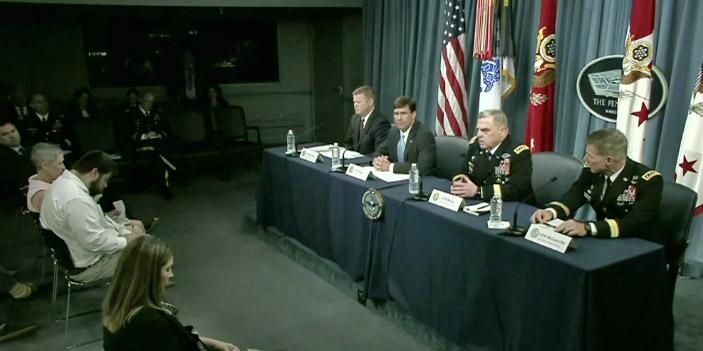Army Futures Command Takes Shape
The U.S. Army took another step toward developing its fourth command when it announced that Austin, Texas, would be the location of the new Futures Command.
The service is pursuing the new command as a way to modernize and position itself “to achieve clear overmatch in future conflicts,” according to the Army. Having a central location for its modernization will unify its efforts, Army leaders said.
“The creation of the Army’s Futures Command constitutes the Army’s most significant reorganization effort since 1973,” said Army Secretary Mark Esper. “It is a new organization that epitomizes our commitment to bold reform and transforming the Army’s modernization process.”
Esper, Army Undersecretary Ryan McCarthy, Army Chief of Staff Gen. Mark Milley, USA, and Army Vice Chief of Staff Gen. James McConville, USA, discussed the service’s plans for the Futures Command at a media briefing at the Pentagon on July 13.
The Army had set aside major modernization programs in order to fight terrorists and insurgents over the last 16 years, explained Gen. Milley. As those fights have wound down, the Army made a conscious decision two and a half years ago to maintain readiness for that fight but also shift gears to reenergize its modernization effort, he said.
“Relative to Russia and China, I think we all recognize that [they] are improving their military capabilities,” Gen. Milley stated. “We decided that we need to reorganize the corporation, so to speak, in order to achieve greater speed, de-layer the organization and reduce bureaucracy… and get the best technology available in the hands of the solider.”
Esper noted that the Army’s last largest modernization effort helped win the Cold War. The service had seen that it was ill-prepared to defeat Soviet forces in a high-intensity conflict in Europe, and that Army equipment, doctrine and training methods had become outdated, he stated. At that time, the service implemented reforms that resulted in the big-five combat systems, the AirLand Battle Doctrine and improved training, including the establishment of the National Training Center. “This increased professionalism throughout the Army,” Esper said.
The Army is looking to achieve similar success through the Futures Command. “Today, once again the Army faces strategic inflection point,” Esper continued. “To address these challenges the National Defense Strategy calls for a more lethal, resilient and rapidly innovating force. The Army Futures Command will establish unity of command and unity of effort, by consolidating the Army’s entire modernization process under one roof. It will turn ideas into actions and through experimenting, prototyping and testing. Most importantly, it will directly incorporate requirements of the warfighter.”
In deciding the location for the command, the Army had considered Boston, Minneapolis-St. Paul, Raleigh-Durham, North Carolina, and Philadelphia, Undersecretary McCarthy said.
“As we looked at each city, …. we envisioned how each city’s ecosystem would support our modernization efforts vertically,” he said.
The service looked at each city’s proximity to STEM workers, industries and private-sector innovation; academic STEM and research and development investments; the level of mature entrepreneurial incubator hubs for collaboration; space and access to top-tier university science and engineering departments for work on experiments, prototype concepts and systems; cost of doing business; and quality of life, among other factors.
Through the Futures Command, the Army is pursuing modernization of the service’s long-range precision fires, a next-generation combat vehicle and other close-combat capabilities, future vertical lift platforms, a sufficiently mobile and expeditionary Army network, air and missile defense capabilities, and increased soldier lethality. Eight cross-functional teams (CFTs), which were stood up over the last year and are reporting to the new command, are helping to deliver innovation to warfighters. The CFTs will continue to manage investment and divestment recommendations, examining capabilities against the modernization priorities and working closely with program executive offices and program managers, according to the Army.
Undersecretary McCarthy and the Chief of Staff announced the plan for the new command and outlined the six modernization priorities last fall. The Army is aiming to have the Futures Command operational by July 2019.





Comment
So will the command issue its
So will the command issue its own SBIRS and BAAs .Will IDIQ contracts be put in place to support work. Where in Austin is the location
Will the Army Office of
Will the Army Office of Business Transformation join the Futures Command?
Comments